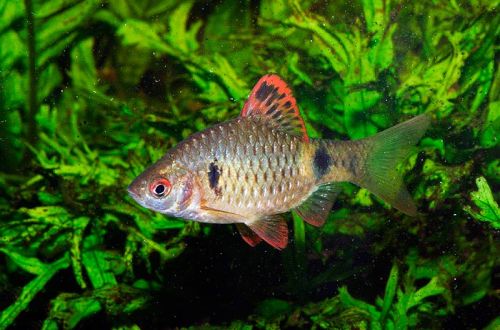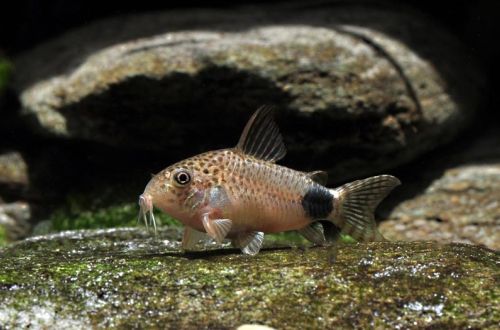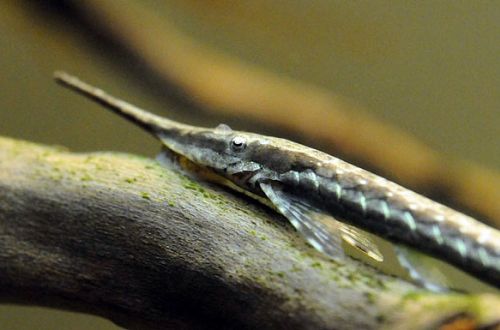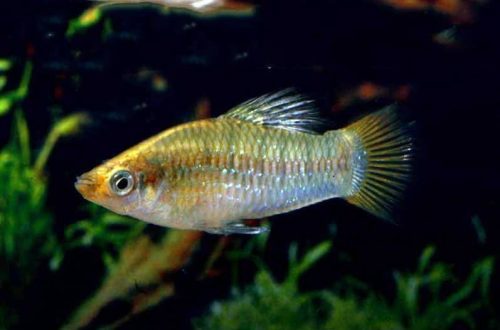
Barbus Stolichka
Barbus Stolichka, scientific name Pethia stoliczkana, belongs to the Cyprinidae family. Named after the Moravian (now Czech Republic) zoologist Ferdinand Stoliczka (1838–1874), who studied the fauna of Indochina for many years and discovered many new species.
This species is considered easy to keep and breed, perfectly compatible with many other popular aquarium fish. May be recommended for beginner aquarists.

Edukiak
Habitat
It comes from Southeast Asia, the habitat covers the territories of such modern states as Thailand, Laos, Myanmar and the Eastern States of India. It occurs everywhere, inhabiting mainly small streams and tributaries, upper reaches of rivers flowing under the canopy of tropical forests.
The natural habitat is characterized by sandy substrates interspersed with stones, the bottom is covered with fallen leaves, along the banks there are many snags and submerged roots of coastal trees. Among aquatic plants, the well-known Cryptocorynes grow in the aquarium hobby.
Informazio laburra:
- Aquariumaren bolumena - 60 litrotik aurrera.
- Tenperatura - 18-26 °C
- Balioa pH - 6.0-7.5
- Uraren gogortasuna - 1-15 dGH
- Substratu mota - edozein
- Argiztapena - baxua, moderatua
- Ur gazia - ez
- Uraren mugimendua - arina edo moderatua
- Arrainaren tamaina 5 cm ingurukoa da.
- Elikadura - tamaina egokiko edozein elikagai
- Tenperamentua - lasaia
- 8-10 pertsonako taldean mantentzea
Deskribapena
Adult individuals reach a length of up to 5 cm. Outwardly, it resembles its close relative Barbus Tikto, which is why they are often confused. The color is light or dark silver. There is a large dark spot at the base of the tail, another one is noticeable behind the gill cover. In males, the dorsal and ventral fins are red with dark specks; in females, they are usually translucent and colorless. The females are generally less colorful.
Janari
Unpretentious and omnivorous species. In a home aquarium, Barbus Stolichka will accept most popular foods of a suitable size (dry, frozen, live). An important condition is the presence of herbal supplements. They may already be present in products, such as dry flakes or granules, or they may be added separately.
Mantentzea eta zaintzea, akuarioaren antolaketa
The optimal tank sizes for a small flock of these fish start at 60 liters. The choice of decoration is not critical, however, the environment of the aquarium, reminiscent of the natural habitat is welcome, so various driftwood, tree leaves, rooting and floating plants will come in handy.
Successful management is largely dependent on maintaining stable water conditions with suitable hydrochemical values. Aquarium maintenance will require several standard procedures, namely: weekly replacement of part of the water with fresh water, regular removal of organic waste, maintenance of equipment and monitoring of pH, dGH, oxidizability parameters.
Portaera eta bateragarritasuna
A peaceful, active schooling fish, compatible with many other non-aggressive species of comparable size. It is recommended to purchase a group of at least 8-10 individuals.
Hazkuntza / hazkuntza
In a favorable environment, spawning occurs regularly. Females scatter eggs in the water column, and males at this moment fertilize it. The incubation period lasts 24-48 hours, after another day the fry that have appeared begin to swim freely. Parental instincts are not developed, so there is no care for offspring. Moreover, adult fish will, on occasion, eat their own caviar and fry.
In order to preserve juveniles, a separate tank with identical water conditions is used – a spawning aquarium, where the eggs are placed immediately after spawning. It is equipped with a simple airlift filter with a sponge and a heater. A separate light source is not required. Unpretentious shade-loving plants or their artificial counterparts are suitable as decoration.
Arrainen gaixotasunak
Espezieen baldintza zehatzak dituen akuario-ekosistema orekatu batean, gaixotasunak oso gutxitan gertatzen dira. Gaixotasunak ingurumenaren narriadurak, gaixo dauden arrainekiko kontaktuak eta lesioek eragiten dituzte. Hori saihestu ezin bada, orduan gehiago tratatzeko sintoma eta metodoei buruz "Akuarioko arrainen gaixotasunak" atalean.





